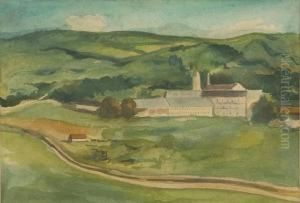Juraj Plancic Paintings
Juraj Plančić was a distinguished Croatian painter and graphic artist, born on July 26, 1899, in Stari Grad on the island of Hvar, which was then part of the Austro-Hungarian Empire. His artistic inclinations were evident from an early age, and he pursued his passion for art despite the limited opportunities available to him on the island. Plančić moved to Zagreb to study at the Royal Crafts School, and later at the Academy of Fine Arts, where he was under the tutelage of well-known Croatian artists such as Tomislav Krizman and Ljubo Babić.
Plančić's work was profoundly influenced by the artistic movements of his time, including Expressionism and Post-Impressionism. He was particularly drawn to the works of Paul Cézanne and the Fauves, whose vibrant use of color and bold brushwork resonated with his own artistic sensibilities. Juraj Plančić was a member of the art group 'Zemlja' (The Earth), which aimed to express social concerns and the spiritual crisis of modern man through art, promoting themes related to the common people and their lives.
Throughout his career, Plančić struggled with poor health and financial difficulties, which often hampered his artistic production. Despite these challenges, he managed to create a body of work that included landscapes, still lifes, portraits, and figurative compositions. His landscapes of Hvar are particularly notable for their evocative portrayal of the island's unique light and atmosphere, capturing the essence of the Mediterranean environment.
Juraj Plančić's life was tragically cut short during World War II. He died on October 27, 1943, at the age of 44, under circumstances that remain unclear, with some sources suggesting he was killed during an Allied bombing raid. His premature death meant that his artistic potential was never fully realized, yet the works he left behind continue to be celebrated for their emotional depth and aesthetic beauty. Plančić remains one of the key figures in Croatian modern art, with his legacy preserved in the country's galleries and museums, as well as in the hearts of art lovers familiar with his poignant and expressive oeuvre.
